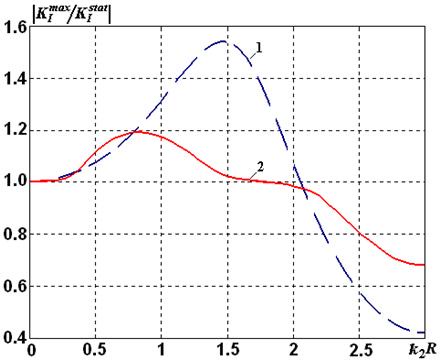Modern conditions of material applications require that structural elements are subjected to various loadings (instantaneous or periodic). However, the behaviour of the materials with intra-component defects under harmonic loading is still a topic under consideration. Wave propagation in cracked solid, unlike in an ideal model material, is accompanied by attenuation, diffraction and scattering of the initial wave. These phenomena are of particular importance to the quantitative non-destructive control of the materials. Therefore, investigation of the problem of cracked solid under harmonic loading is an important task.
 |
 |
| a) |
b) |
Fig.1 (a) - crack in material; (b) - stresses in the vicinity of the crack tip
Under deformation the opposite faces of the existing cracks interact with each other, altering significantly the stress fields near the crack tips. The nature of the contact interaction between two crack surfaces is very complex. The direct observation and measurement of the contact characteristics is impossible since the area of interest is hidden in the solid. Furthermore, under deformation of the material the initial contact area will change in time. Its shape is unknown beforehand and must be determined as a part of solution.
 |
 |
| a) |
b) |
Fig. 2 (a) - Boundary elements discretization for a penny-shaped crack surface; (b) - Stress intensity factor (normal mode): 1 - neglecting contact interaction; 2 - taking contact interaction into account
The current project is devoted to the investigation of the contact interaction of the faces of linear cracks in 2-D and penny-shaped cracks in 3-D homogeneous, isotropic, linear elastic solid under harmonic loading. The problems of wave incidence on cracked materials were solved numerically by the method of the boundary elements with the use of the iterative procedure.
 |
 |
| a) |
b) |
Fig. 3 Stress intensity factor (normal mode):
(a) -The wave number and the angle of incidence ; (b) - The effect of the crack faces contact interaction
The results are very promising. Even the rough estimation confirmed that the crack faces contact interaction significantly influences the stress-strain state in the vicinity of the crack, and affects the distribution of the stress intensity factors. For example, in the case of the penny-shaped crack under normal tension-compression wave the contact interaction changes solution both quantitatively and qualitatively. The maximal values of the comparable stress intensity factors do not coincide (the difference can reach 50%) and are achieved at different wave frequencies. And, the most importantly, the real maximal value of intensity factor evaluated taking into account the contact of crack faces is much smaller, than previously predicted (i.e. disregarding the contact interaction). In the same time, for structures working within certain ranges of the loading the maximal value of the stress intensity factor is significantly higher than previously predicted.
Related publications:
-
Menshykov OV, Guz IA. Elastodynamic problem for two penny-shaped cracks: The effect of cracks' closure. International Journal of Fracture, 2008, 153(1), pp.69-76.
-
Menshykov OV, Menshykova MV, Guz IA. Effect of friction of the crack faces for a linear crack under an oblique harmonic loading. International Journal of Engineering Sciences. 2008, 46(5), pp.438-458.
-
Menshykov OV, Menshykov VA, Guz IA. The contact problem for an open penny-shaped crack under normally incident tension-compression wave. Engineering Fracture Mechanics. 2008, 75(5), pp.1114-1126.
-
Menshykov OV, Guz IA. Effect of contact interaction of the crack faces for a crack under harmonic loading. International Applied Mechanics. 2007, 43(7), pp.809-815.
-
Guz AN, Menshykov OV, Zozulya VV, Guz IA. Contact problem for the flat elliptical crack under normally incident shearwave. CMES - Computer Modeling in Engineering & Sciences. 2007, 17(3), pp.205-214.
-
Menshykov OV, Mykhailova II, Guz IA. Semi-analytical modelling of cracks with interacting faces in isotropic materials under harmonic load. PAMM - Proceedings in Applied Mathematics and Mechanics. 2007, 7(1), pp.4030023-4030024.
-
Menshykov AV, Guz IA. Accounting for friction under the harmonic loading of a penny-shaped crack. Proceedings of the National Academy of Sciences of Ukraine, 2007, No.1, pp.77-82.
-
Menshykov O, Guz IA. Contact interaction of crack faces under oblique incidence of a harmonic wave. International Journal of Fracture. 2006. 139(1), pp.145-152.
-
Guz AN, Zozulya VV. Investigation of the effect of frictional contact in III-mode crack under action of the SH-Wave harmonic load. CMES - Computer Modeling in Engineering & Sciences. 2007, 22(2), pp.119-128.
-
Guz AN, Zozulya VV, Menshikov AV. General spatial dynamic problem for an elliptic crack under the action of a normal shear wave, with consideration for the contact interaction of the crack faces. International Applied Mechanics, 2004. 40(2), pp.156-159.
-
Menshykov OV, Menshykova MV, Wendland WL. On use the Galerkin method to solve the elastodynamic problem for a linear crack under normal loading, International Applied Mechanics, 2005, 41(11), pp.1324-1329.
-
Menshykov OV, Menshykova MV. Investigation of the crack faces contact interaction by the Galerkin method, Theoretical and Applied Mechanics, 2005, 41, pp.159-163.
-
Menshykov OV. Application of the Galerkin method to solve the problem for the space with a crack under harmonic loading, Proceedings of the National Academy of Sciences of Ukraine, 2005, No.8, pp.44-48.
-
Menshykov OV. Spatial contact problem for two coaxial penny-shaped cracks under normal harmonic loading, Proceedings of the National Academy of Sciences of Ukraine, 2005, No.6, pp.44-49.
-
Menshykov OV. The allowance for the contact of the faces of a stationary penny-shaped crack under harmonic loading, Proceedings of the National Academy of Sciences of Ukraine, 2004, No.8, pp. 43-47.
-
Menshykov OV. Influence of the elliptical crack's faces contact interaction on the distribution of the stress intensity factor (mode I), Proceedings of the National Academy of Sciences of Ukraine, 2004, No.7, pp.43-48.
